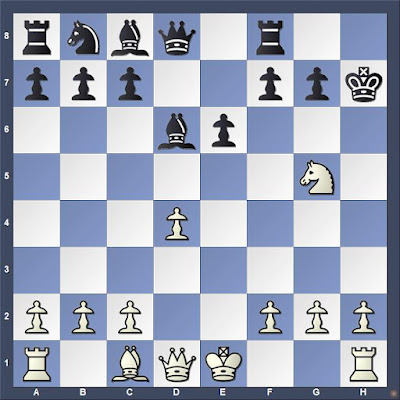Gioachino Greco's explorations of an inaccuracy common among beginners deserve attention. This post does that, as promised in "
How Bad is 2...Qf6?" Greco's games with 2...Qf6 all begin:
1.e4 e5 2.Nf3 Qf6 3.Bc4 Qg6 4.O-O Qxe4 5.Bxf7Black to move

Greco's explorations of this queen foray appear in the
Paris (1625) and
Orléans (n.d.) manuscripts. Peter J. Monté notes in
The Classical Era of Modern Chess (2014) that
Orléans was likely copied from the
Paris MS (339), although some errors were corrected. Part II of this book, "Openings and Games of the Classical Era of Modern Chess" (439-530), has been an indispensable resource.
I
have contended that Greco's games are poorly known, even by those who think they have studied all of them. Most players access these games through ChessBase or websites such as
chessgames.com (currently 90 games). The latter has more Greco games, but both offer shorter versions of what is available in such old books as "Professor Hoffmann" [Angelo Lewis],
The Games of Greco (1900), and William Lewis,
Gioachino Greco on the Game of Chess (1819). These shorter versions miss the best of Greco's analysis.
A couple of years before the earliest version of what eventually became ChessBase Mega, David Levy and Kevin O'Connell made an effort to record all known games up to 1866 in
Oxford Encyclopedia of Chess Games, Volume 1 1485-1866 (1981). They offer 77 Greco games, many annotated. These are extracted from Hoffmann's text. As with Lewis before him, Hoffmann buried the best analysis in the variations, which sometimes are much longer than the main game. Levy and O'Connell continue this practice.
The games in ChessBase come close to representing these abbreviated "main games" sans the variations. If the longest variation of each game were the main game instead, what most chess players know of Greco would be substantially enriched. Here I offer improved versions with notes. The notes show other lines that appear in Greco's manuscripts and in Hoffmann.
Greco,Gioachino [C40]Paris, 1625
1.e4 e5 2.Nf3 Qf6 3.Bc4 Qg6ChessBase Mega 2020 has four games with this move. Three are Greco's. The other was a fighting draw played in Germany in 2010. No rating is given for the player of Black, while White's is slightly over 2000.
4.0-0 Qxe4 5.Bxf7+All of Greco's games reach this point. The analysis continues with lines that follow all three of Black's legal moves.
5...Kd85...Kxf7 6.Ng5+ Ke8 7.Nxe4 matches a game in CB Mega 2020 and also appears in the
Paris MS.
White to move

6.Nxe5 Nf6 6...Qxe5 7.Re1 Qf6 8.Re8#
Orléans. Game XXI, var. A in Hoffmann. This line ends with the same checkmate that can be found in one of the Greco selections in CB Mega 2020.
7.Re1 Qf5 8.Bg6
Black to move
8...Qe6 8...hxg6 9.Nf7# Game XXI, var. B in Hoffmann;
Paris and
Orléans MSS.
9.Nf7+ Ke8 10.Nxh8+ hxg6 11.Rxe6+ dxe6 12.Nxg6 1-0Black to move
This game and its variations appear in
Paris MS (1625) XXXIII;
Orléans MS XXII. The game is XXI, var. C in Hoffmann.
Greco,Gioachino [C40]Paris, 1625
1.e4 e5 2.Nf3 Qf6 3.Bc4 Qg6 4.0-0 Qxe4 5.Bxf7+ Ke7 White to move
Greco considers every legal move for Black after the bishop check.
6.Re1 Qf4 7.Rxe5+ Black to move
Here, also, Greco considers every legal move for Black.
7...Kxf7 7...Kd8
Paris MS (1625) XXXIV. 8.Re8# This game appears in ChessBase Mega 2020.
7...Kf6 8.d4 Qg4 9.Bh5
Paris MS XXXIV.
7...Kd6 8.Rd5+ Kc6 9.Nd4+
Paris MS (9.Ne5+
Orléans MS)
8.d4 Qf6 9.Ng5+ Kg6 10.Qd3+ Black to move
10...Kh5 10...Kh6 11.Nf7# is given as the main line in Levy and O'Connell. Hoffmann, game XXII.
An essential aspect of Greco's technique in dealing with the horrid positions for which he is well-known is to seek to improve the losing side's defenses. When only the shortest versions of these games are known, this technique is hidden.
11.Nf7+ 11.g4+ is not attested by Monte, but is found in CB Mega 2020.
11.Nf3+ Kg4 (11...g5 12.Rxg5+) 12.h3#
Orléans MS.
11...Kg4 11...g5 12.Rxg5+ Game XXII, var. B in Hoffmann.
White to move

12.h3+ Hoffmann writes, "Greco gives this move as mate, but this is obviously a slip, Black still having one square available" (65). Monte notes this error in Paris XXXIII (477).
12.Qg3# Monte notes that Greco overlooks this mate.
12...Kh4 13.Qg3# 1-0This game appears in the
Paris MS (1625) XXXIII. Also as Game XXII, var. A in Hoffmann.
Greco,Gioachino [C40]
Orléans, 1625
1.e4 e5 2.Nf3 Qf6 3.Bc4 Qg6 4.0-0 Qxe4 5.Bxf7+ Ke7 5...Kxf7 6.Ng5+ Ke8 7.Nxe4 is found in CB Mega 2020
6.Re1 Black to move
6...Qf4 7.Rxe5+ Kd6 7...Kf6 8.d4 Qg4 9.Bh5 Game XXIII, var. A in Hoffmann.
7...Kd8 8.Re8#
Paris MS (1625) XXXIV;
Orléans MS. Game XXIII in Hoffmann. This version is in CB Mega 2020.
8.Rd5+ Ke7 9.Qe1+ Kxf7 10.d4 Qf6 White to move
11.Ng5+ Kg6 12.Qe8+ Paris MS has an error here, corrected in
Orléans.
12...Kh6 13.Nf7+ Kg6 White to move
14.Nxh8# 1-0
This game appears in the Orléans MS. Also Game XXIII, var. B in Hoffmann.
My view is that Greco's attacking technique against the best defense he found for Black is quite instructive. Of course, 2...Qf6 is a bad move, and 3...Qg6 is worse. Nonetheless, the simple refutations offered in the sample of these games in ChessBase Mega and on database websites have unjustifiably tarnished Greco's reputation. Much more of value exists in his model games than is generally believed.































































